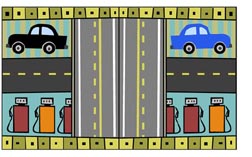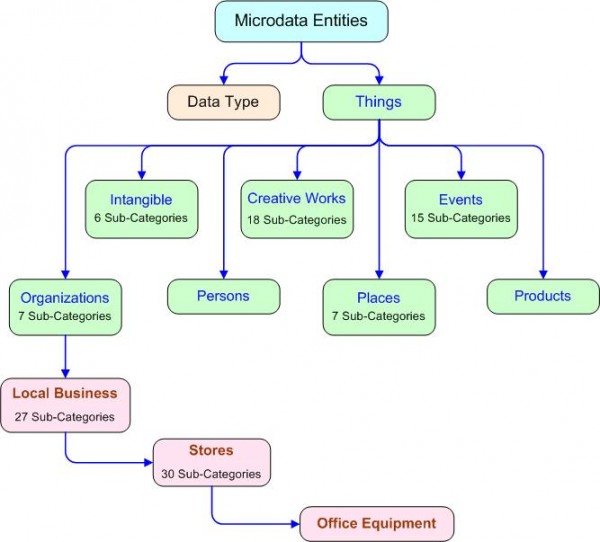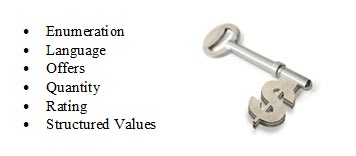MicroData For Marketing Executives
This continues the analysis presented in the MicroData Not Ready For Primetime article previously published. Here, I break down the MicroData hierarchy into three levels so marketing professionals can review each category to see what value it can bring to future marketing, content and SEO initiatives. When you look at the type schema you see close […]

When you look at the type schema you see close to 300 metadata elements that can describe various entities (called Things here).
There is lot of specificity in a few categories such as Local Businesses, Civic Structures and Events. Two of these categories have real implications for local and mobile SEO because of the richness of the metadata.
Below you see the high-level organizational taxonomy for the MicroData entities. It has up to five levels depending upon which category you are looking at. Here you see that three levels are associated with Local Business, while the Persons and Product groups have no subcategories.
Things
The high-level property elements for Things include Name, URL, Image and Description. These properties are applied to all of the following seven subcategories.
- Creative Work — Text and metadata include ratings, reviews and offers.
- Events — Metadata elements includes time, who, place and related events.
- Intangibles — This is dynamic metadata about quantities and values.
- Organizations — Metadata to include location, founders, employees and contact info.
- Persons — Metadata includes title, awards, affiliations, family relationships, personal information and contact information.
- Places — Metadata about photos, maps, addresses and contact information
- Products — Metadata about brand, model, manufacturer and reviews.
Let’s take a look at each of these seven categories in a little more detail to see what might be valuable to a B2B marketing executive. Not all will be useful; some will be pure media plays, while others will be B2C oriented.
Creative Works
The properties available in the Creative Works category are metadata elements used to describe all the elements of a piece of creative work. This includes things like identifying headlines, the editor, genre and author. Many more properties are described at the creative works link above.
The properties apply to all the subcategories in the Creative Works group, which include the following types:
Events
Eleven properties are available in the Events category for describing web pages that contain event information. Events can also be broken into super or subevents. For example, if you are putting on several presentations at trades shows, these can be called out individually. Subcategories for events include:
Intangibles
The four properties available in the Intangibles category describe dynamic or intangible data. Examples include the format of a book, the condition of an item, the price, the availability and the seller of the item. Sub-categories include:
Organizations
The 16 properties available in the Organizations category are for classifying data elements that deal with common company information. A large number of the properties focus on contact information, company facts and employees. There are also ratings and review properties.
Person
There are 27 properties available in the Persons category for classifying data elements about a person. You find properties that describe organizational affiliations, alumni status, job title, nationality and the name of the person’s spouse.
There are no subcategories for the Persons group, which is surprising. When you review business websites in any number you see a handful of very defined groups of people. Almost every website has a listing for their Board of Directors, C-level executive, advisory / technical boards and other named teams.
Often, the names of investors are provided as well. You could tag a person with the job title property. If you have a board with seven members you would have to do this seven times. Having a named subgroup that includes more than one individual makes more sense because this reflects current common practice on the Internet.
Place
The 12 properties in the Places category describe unique locations such as a building or a landform. You can specify that a place is part of a larger geographic location. Beyond this the properties are what you would expect: maps, photos, address and telephone numbers.
The Local Business subgroup below is the same one found in the Organizations category.
Products
The seven properties in the Products category are for describing the elements of a product. These properties include specifying a brand name, the manufacturer’s name and product identification numbers, to name a few.
Given the prominent role that products play in Internet commerce, I was surprised at how few properties there are, and I think this will be an issue for successfully deploying the MicroData standard.
Here are some of the elements that I think are missing:
- High-level designation: is it a B2B product or a B2C product.
- Age range for the intended product.
- Industry target: e.g., healthcare, entertainment, financial and technology.
- Product category: e.g., books, clothing, garden, grocery and sports.
- Gender: shoes for example.
- Price or price range.
To be fair, some of these properties are found in the Intangibles category, such as price and seller property. But why these properties are there instead of in Products is a real mystery.
The second problem with this category is there are no subcategories at all for the Products group. It’s almost impossible to find a shopping site that does not have a product taxonomy that is used to navigationally organize company’s wares.
These taxonomies exist for a reason: They work for both the website owner and the consumer. This section really needs to be expanded in the next version of the MicroData specification.
Local Business

One of the Local Businesses subcategories called Stores has 30 subcategories in its group alone.
Business names could be used to complement what is missing in the Product category, but it’s far from optimal. For example there is no Internet, Software or Technology categories in the existing taxonomy. The subcategories for Local Business include:
- Animal Shelter
- Automotive Business (ten subcategories)
- Child Care
- Dry Cleaning / Laundry
- Emergency Service (three subcategories)
- Employment Agency
- Entertainment Business (seven subcategories)
- Financial Service (four subcategories)
- Food Establishment (eight subcategories)
- Government Office (one subcategories)
- Health And Beauty Business (five subcategories)
- Home And Construction Business (eight subcategories)
- Internet Cafe
- Library
- Lodging Business (four subcategories)
- Medical Organization (seven subcategories)
- Professional Service (ten subcategories)
- Radio Station
- Real Estate Agent
- Recycling Center
- Self-Storage
- Shopping Center
- Sports Activity Location
- Store (30 subcategories)
- Television Station
- Tourist Information Center
- Travel Agency
Data Type

For example, being able to define a table, having it survive the indexing process intact as a single entity and returning it as a single search result is certainly valuable. Being able to define an image as a chart or an Excel table would also be useful, but these data types are not supported.
- Boolean
- Date
- Number
- Text
Summary
When you look at the subcategories for most of the above groups, it’s easy to see how the MicroData specification is of value, especially the Local Business category. For example, the properties in Local Business provide more markup opportunities for your local SEO strategy.
However, the lack of definition in the Product category makes this a less-than-compelling tool for those firms that sell brick and mortar products through their websites.
Contributing authors are invited to create content for Search Engine Land and are chosen for their expertise and contribution to the search community. Our contributors work under the oversight of the editorial staff and contributions are checked for quality and relevance to our readers. The opinions they express are their own.
Related stories
New on Search Engine Land





